Himalayan Pilgrimage
The sacred Ganges, glorified for her
connection with Lord Krsna’s pastimes,
inspires an arduous journey to her
historical, mystical source.
by Satyaraja dasa and Jagatguru Swami

Our Pan Am jet arrived in New Delhi late one mid-September night, and by 12:15 A.M. our party of three had passed through the final immigration and customs formalities. We secured a rented car and began to make our way through the darkened streets, until soon we were outside the city and heading north. Our destination was Hardwar and Rishikesh, some 120 miles away. For months we had anticipated seeing these two holy cities, situated in the picturesque foothills of the Himalayas. Back in New York it had seemed like a distant dream. Now, we knew the dream would soon become a reality.
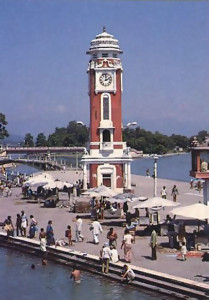
Srila Prabhupada, the founder and spiritual master of the International Society for Krishna Consciousness, describes the Himalayas as a centuries-old refuge for great yogis and ascetics aspiring to realize the Absolute Truth. The Himalayas are also famous as the source of the sacred Ganges. And it was this river, glorified for its intimate connection with the manifest pastimes of Lord Krsna, that had inspired our pilgrimage. We had come to visit the source of the glorious Ganges.
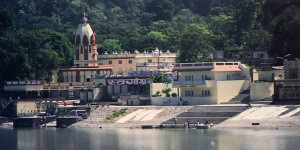
the yellow house where Srila Prabhupada, the Hare Krsna movement’s founder and spiritual master, stayed while visiting the holy city in 1977.
We arrived in Hardwar before dawn and glimpsed in the moonlight the swift-flowing river. Drawing from the western Himalayas and the northern slopes of the Vindhya range, the Ganges flows eastward, until, near Allahabad, it is joined by another sacred river, the Yamuna. The Ganges the continues eastward until it reaches the Bay of Bengal, a total distance of more than fifteen hundred miles.

Perhaps the most extraordinary thing about the Ganges is her purity. Even today, when she is exposed to a tremendous amount of chemical waste as well as other pollutants, she remains pure, and millions of pilgrims come to bathe in and drink her waters. Dr. John Howard Northrup, a co-winner of the Nobel Prize for Chemistry in 1946, has said, “We know the Ganges is highly contaminated. Yet Indians drink out of it, swim in it, and are apparently not affected . . . . Perhaps bacteriophage [a bacteria-destroying virus normally present in sewage] renders the river sterile.” Whatever the reason, the Ganges is pure. And in Hardwar viewing the Ganges, we had little doubt of this. In fact, Hardwar was itself a gateway into this purity, and any perceptive pilgrim can sense it. “Hardwar” is a common spelling and pronunciation of the Sanskrit hari-dvara. Hari is a name for God, and dvara means “door” or “gate.” Thus the holy city of Hardwar is celebrated as the gateway to God.

Deciding to rest for an hour or so, until sunrise, we spread out our sleeping bags. We talked excitedly about the adventure the coming day would hold, and as the moments passed, we realized that we would not be able to sleep. Thus, after an hour and a half, just as the sun began to climb over the Himalayan foothills, we rolled up our bags and started our day. Placing three drops of Ganges water on our heads—a reverential gesture—we entered the water to take our morning bath. This was at Harki Puri, a famous bathing ghata visited by millions of pilgrims each year.
According to Vedic tradition, one who bathes in the Ganges is freed from the reactions of all his past sins and also becomes eligible for liberation from birth and death. Of course, if after bathing one returns to sinful life, the purification loses its meaning. One becomes like the elephant who bathes and then returns to the shore and spreads mud all over his body.

Real liberation means to become free not only from the reactions of past sins but also from the desire to commit further sins. This is clearly taught in the Vedic literature, especially in the commentaries by His Divine Grace A.C. Bhaktivedanta Swami Prabhupada. Thus, as Srila Prabhupada’s disciples, we were aware of the pitfalls, and we resolved to bathe in the Ganges with proper respect. We also resolved not to dirty ourselves again, but to be pure by strictly adhering to our vows of changing the Hare Krsna mantra on our beads sixteen rounds a day (One round is 108 repetitions of the Hare Krsna mantra) and abstaining from meat-eating, illicit sex, intoxication, and gambling.

From Hardwar we drove fifteen miles along the Ganges to Rishikesh, the location of numerous schools and asramas. Thousands of years ago, yogis and rsis would migrate here as well. We stopped at a spot close to the river and the Laxman Jula Cable Bridge. As we sat on the rough, rocky riverbank, we looked out at the many granite boulders that jutted out of the waters. Feeling inspired by the auspicious setting and the awesome Himalayas looming in the distance, we unpacked our beads and began to chant—Hare Krsna, Hare Krsna, Krsna Krsna, Hare Hare / Hare Rama, Hare Rama, Rama Rama, Hare Hare.
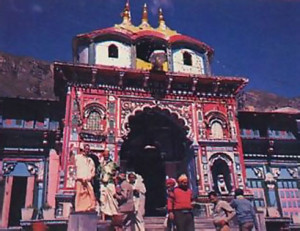
As we sat absorbed in our chanting, we noticed two men who appeared to be Westerners crossing the Ganges via the cable bridge. The young men, upon arrival, sat on the large rocks, a few hundred feet away from us. Sitting crosslegged, they began to meditate, their eyes tightly shut. After barely ten minutes they broke their meditation and began smoking, revealing their meditation to be a farce. They both began carrying on like typical tourists, oblivious of the sacred place of pilgrimage. This reminded us that the full benefit of any spiritual endeavor, such as visiting the source of the Ganges, is to be had only under the direction of a bona fide spiritual master. Our two friends simply did not know better.
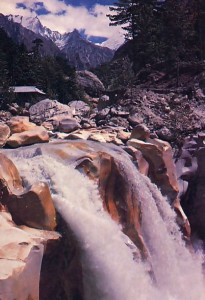
Actually the meditation practiced by the sages of antiquity is not possible today. Even if one retreats to the Himalayas, one’s old habits—like smoking—will return. Therefore, the Vedas describe the present age, Kali-yuga, as one in which silent meditation is impossible. To perfect the techniques of yogic meditation traditionally took hundreds if not thousands of years, in an age in which such a long duration of life was possible. Thus, for this age the Vedic literature recommends mantra meditation, chanting aloud the names of God. Today, the real yogis chant Hare Krsna.
After completing our vow of chanting sixteen rounds on our beads, we proceeded toward our destination: Gomukh, the source of the Ganges. There, at fourteen thousand feet, the Ganges emerges from beneath the Bhagirath glacier.
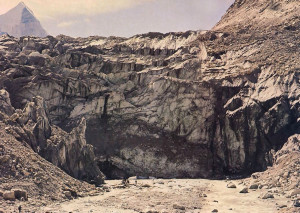
The journey, first by car and then by foot, was to take four days-barring any trouble. But on our first day we ran into trouble. The road had been washed out by a tributary of the Ganges, and our car could go no further. So with only our camera equipment and light shoulder bags containing the bare necessities, we continued on foot.
Soon we came to a swift mountain stream. On the other side, we boarded a bus that took us to the high-country town of Uttar Kashi, where we spent the night. Early the next morning we caught the bus for the town of Lanka, sixty miles away. Our progress was slow because of the treacherous mountain roads, and our journey took more than seven hours. The frustrations of the arduous trip were counterbalanced, however, by occasional glimpses of snowy Himalayan peaks in the distance.

After spending the night in Lanka, we proceeded on foot to Gangotri—the end of the line for most pilgrims. Here, at the base of this magnificent glacier valley, the Ganges surged forward, plunging forty feet into a deep and narrow ravine. The silvery Ganges water was cold and clear, and as we tasted it Lord Krsna’s words came to us: “I am the taste of water.”
Taking the help of a local guide, we began the last eleven miles of our upward pilgrimage, from Gangotri at ten thousand feet to Gomukh at fourteen thousand feet. As we proceeded, we noted frost on the ground and a light snowfall on the surrounding peaks. Keeping a brisk step, we hiked up the winding path, higher and higher. Evening came, and we camped for the night.

The next morning, with only three miles remaining, we set out for Gomukh. When we arrived, we saw that the Ganges appeared to be coming out from under a very large stone cliff. But upon closer inspection we realized this was not a stone cliff at all, but a gigantic wall of solid ice. Behind the massive glacier towered the Bhagirath peak, a temple spire crowning the sacred Ganges. This holy spot is as far as one can go in tracing the origin of the sacred river. We felt fortunate to be there.
As dutiful pilgrims, we decided to pay homage by taking our midday bath in the icy waters. This was as much an austerity as reaching the place, but we ecstatically chanted “Hare Krsna” and took our-brrr-bath. It was great fun and spiritually purifying as well.
After bathing, we discussed the descriptions of the origin of the Ganges presented in the Vedic literature. Although Gomukh is the origin of the Ganges here on earth, it is said that the Ganges actually originates in the heavenly planets. King Bhagiratha, by his prayers, brought the Ganges to our planet millennia ago. And it was Vamanadeva, an incarnation of Lord Krsna, who brought water from the spiritual world to the material to create the sacred Ganges. As we discussed all this, we realized how skeptical many Westerners would be. But we weren’t about to let someone else’s limited, materialistic vision influence our appreciation of the Lord’s divine pastimes. The Supreme Personality of Godhead can do anything, no matter how difficult it may seem to mundane eyes. We were there, and we could feel the spiritual energy.
For the devotee of the Lord, the descent of the Ganges is not a fanciful story; it is fact. All too often mundane scholars make the mistake of relegating transcendental phenomena to the realm of mythology or legend. Trying to accommodate the unlimited within their limited scope, they ridicule Vedic stories as “impossible” or “fantastic.” Well, the descent of the Ganges is fantastic and, by mundane standards, impossible. But is a transcendental phenomenon to be judged by mundane standards? We shouldn’t try to make God fit within our limited experience and understanding. Indeed, He is always beyond these things. Without His being able to appear in various incarnations and perform superhuman activities, there is no meaning to the words “Supreme Lord.” He is the source of all “fantastic” things, like the Ganges. And if one doesn’t believe it, let him go to the Himalayas, to Gomukh, and see for himself.
The Descent of the Ganges
A Historical Account from the Srimad-Bhagavatam
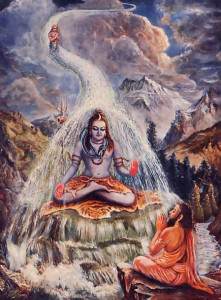 The ancient Vedic literature of India informs us that there are three planetary systems in this universe: the upper, or heavenly, planets; the middle planets, including Earth; and the lower, or hellish, planets. The entire universe is enclosed in an immense shell, which is millions of miles thick. Beyond this shell lies the spiritual world and the spiritual waters of the Karana Ocean.
The ancient Vedic literature of India informs us that there are three planetary systems in this universe: the upper, or heavenly, planets; the middle planets, including Earth; and the lower, or hellish, planets. The entire universe is enclosed in an immense shell, which is millions of miles thick. Beyond this shell lies the spiritual world and the spiritual waters of the Karana Ocean.
The Srimad-Bhagavatam tells how once, long ago, a king name Bali Maharaja conquered all three planetary systems. Ousting the demigods the Supreme Personality of Godhead Krsna’s deputed managers of universal affairs from their heavenly domains, he installed himself as the king of heaven. Aditi, thc mother of the demigods, aggrieved at her sons’ defeat, fasted and prayed to Lord Krsna for twelve consecutive days. Pleased with Aditi, the Lord agreed to reinstate the demigods by incarnating as Vamanadeva, a dwarf brahmana mendicant.
Lord Vamanadeva, appearing as the ideal brahmana (saintly priest), approached Bali Maharaja and begged him for a mere three paces of land. When Bali agreed, Vamanadeva covered the entire universe with two steps, thus reclaiming the demigods’ lost property. With His third step, Vamanadeva kicked a hole in the universal shell with His toe, causing a few drops of Karana water to leak into the universe. This water became the Ganges river, which is thus considered sacred and purifying, both because it comes from the spiritual world and because it touched the toe of Lord Vamanadeva.
At first the Ganges flowed only in the heavenly planets. Then a great earthly king named Bhagiratha, who was a devotee of Lord Visnu, desiring to have the Ganges purify the earth, prayed for the river to descend. The Ganges personified appeared before King Bhagiratha and agreed to fulfill his desire. But she had a reservation.
“When I fall from the sky to the surface of the planet earth,” she explained, “the water will certainly be very forceful. Who will sustain that force? If I am not sustained, I shall pierce the surface of the earth, and then I shall glide down to the hellish planets.”
Mother Ganges was afraid that in falling from the heavenly planets her waters would carve a hole through the earth and she would thus descend into hell. She therefore asked King Bhagiratha to find someone who was willing and able to break her fall.
To satisfy mother Ganges, King Bhagiratha prayed to Lord Siva, who is a powerful incarnation and the greatest devotee of Lord Visnu. When the king asked the powerful Lord Siva to catch the falling Ganges water on his head, Lord Siva agreed to the request, saying simply. “Let it be so.”
Since that time, Lord Siva has been sustaining mother Ganges on his head. and the waters of the sacred river have been flowing on the earth, purifying all those who come in contact with them. The Himalayan mountain and glacier from which the Ganges flows are still named after King Bhagiratha. According to the Vedic literature, anyone who bathes in the Ganges is cleansed of all material contamination and becomes eligible to be liberated and return to the eternal spiritual world, where the Ganges originates.

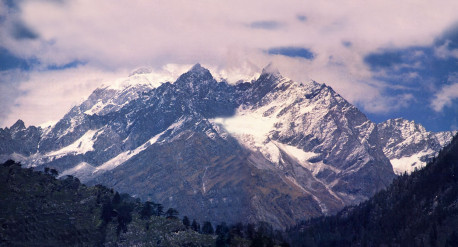
Leave a Reply